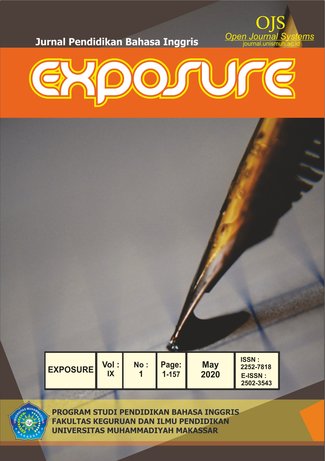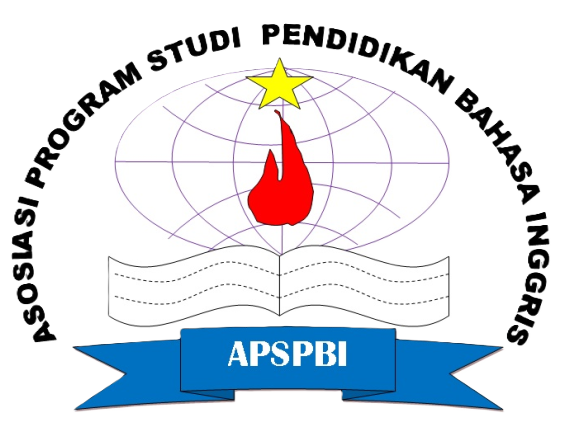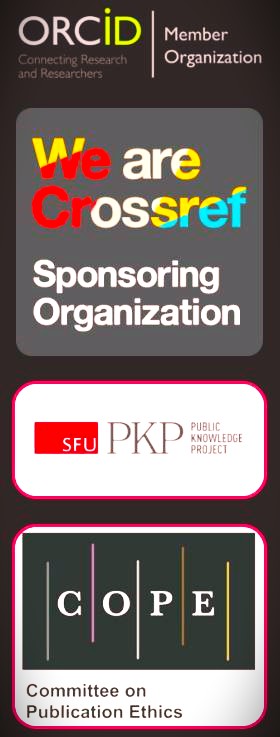COLLABORATIVE LEARNING AS THE MANIFESTATION OF SOCIOCULTURAL THEORY: TEACHERS’ PERSPECTIVES
DOI: https://doi.org/10.26618/exposure.v9i1.2888
collaborative learning, sociocultural theory, teachers’ perspective, teachers’ barrier in collaborative learning, foregoing grounds of teachers’ barrier
Abstract
The purpose of the study is to identify the teachers’ barriers in implementing collaborative learning in EFL classrooms. The study was conducted at Universitas Muhammadiyah Sidoarjo with two teachers as the participants. Additionally, the study employed a qualitative research method by using an in-depth interview to obtain the data. The findings of the study showed that it is difficult to assess students in collaborative work activities besides organizing the doings in the approach. To solve the problems, teachers should pay more attention to students’ group performance, the social interaction, and mutual support of each member of the group rather than focus on group productivity and individual performance in assessing the students’ achievement.
References
Baker, T., & Clark, J. (2010). Cooperative Learning – A Double-Edge Sword: A Cooperative Learning Model for Use with Diverse Student Groups. Intercultural Education, 21(3), 257-268.
Barron, B. (2003). When Smart Groups Fail. Journal of the Learning Sciences, 12(3), 217-226.
Behroozizad, S., Nambiar, R.M.K., & Amir, Z. (2014). Sociocultural Theory as an Approach to Aid EFL Learners. The Reading Matrix, 14(2), 217-226.
Blatchford, P., Kutnick, P., Baines, E., & Galton, M. (2003). Toward a Social Pedagogy of Classroom Group Work. International Journal of Educational Research, 39 (1-2), 153-172.
Brown, H.D. (1994). Teaching by Principles: An Interactive Approach to Language Pedagogy. London: Prentice-Hall.
Cantwell, R.H. & Andrews, B. (2002). Cognitive and Psychological Factors Underlying Secondary Students’ Feelings towards Group Work. Educational Psychology, 22(1): 75-91.
Chiriac, E.H., & Granstrom, K. (2012). Teacher’s Leadership and Students’ Experience of Group Work. Teachers and Teaching, 18(3), 345-363.
Contreras León, J.J., & Chapetón, C.M. (2016). Cooperative Learning with a Focus on the Social: A Pedagogical Proposal for the EFL Classroom. HOW, 23(2), 125-147.
Creswell, J.W. (1998). Qualitative Inquiry and Research Design: Choosing among Five Traditions. London: SAGE Publications.
DiNitto, R. (2000). Can Collaboration be Unsuccessful? A Sociocultural Analysis of Classroom Setting and Japanese L2 Performance in Group Tasks. Journal of Association Teach, 34(2): 179-210.
Gardner, R.C. (1985). Social Psychology and Second Language Learning: The Role of Attitudes and Motivation. London: Edward Arnold.
Gerlach, J.M. (1994). Is This Collaboration? In K. Bosworth & S. J. Hamilton (Eds.), Collaborative Learning: Underlying Processes and Effective Techniques (pp. 12-19). San Francisco: Jossey-Bass.
Gillies, R.M. (2004). The Effects of Cooperative Learning on Junior High School Students during Small Group Learning. Learning and Instruction, 14(2), 197–213.
Gillies, R.M. & Boyle, M. (2010). Teachers’ Reflections on Cooperative Learning: Issues of Implementation. Teaching and Teacher Education, 26(4), 933-940.
Hamalainen, R. & Vahasantanen, K. (2011). Theoretical and Pedagogical Perspectives on Orchestrating Creativity and Collaborative Learning. Educational Research Review, 6(3), 169-184.
Hmelo-silver, C.E., Chinn, C.A., Chan, C.K.K., Angela, M., & Donnell, O. (2019). The International Handbook of Collaborative Learning. London: Routledge.
Janssen, J., Erkens, G., Kanselaar, G., & Jaspers, J. (2007). Visualization of Participation: Does it Contribute to Successful Computer-supported Collaborative Learning? Computer & Education, 49(4), 1037-1065.
Jiang, Y.M. (2009). Applying Group Work to Improve College Students’ Oral English. International Education Students. 2(3): 136-139.
Johnson, D.W., Johnson, R.T., & Smith, K. (2007). The State of Cooperative Learning in Postsecondary and Professional Settings. Educational Psychology Review, 19(1). 15-29.
Kaendler, C., Wiedmann, M., Rummel, N., Spada, H., & Rev, E.P. (2014). Teacher Competencies for the Implementation of Collaborative Learning in the Classroom: A Framework and Research Review. Educational Psychology Review, 27, 505-536.
Khosa, D.K. &Volet, S.E. (2013). Promoting Effective Collaborative Case-based Learning at University: A Metacognitive Intervention. Studies in Higher Education, 38(6), 870–889.
Krashen, S.D. (1981). Second Language Acquisition and Second Language Learning. Oxford: Pergamon Press.
Kreijns, K., Kirschner, P.A., & Jochems, W. (2003). Identifying the Pitfalls for Social Interaction in Computer-supported Collaborative Learning Environments: A Review of the Research. Computers in Human Behavior, 19(3), 335-353.
Lave, J., & Wenger, E. (1991). Situated Learning: Legitimate Peripheral Participation. Cambridge: Cambridge University Press.
Lin, L. (2015). Exploring Collaborative Learning: Theoretical and Conceptual Perspectives. In: Investigating Chinese HE EFL Classrooms (pp. 11-28). Berlin: Springer.
Maesin, A., Mansor, M., Shafie, L.A., & Nayan, S. (2009). A Study of Collaborative Learning among Malaysian Undergraduates. Asian Social Science, 5(7): 70-76.
Marcela, C., & Castro, C. (2017). Transforming EFL Classroom Practices and Promoting Students ’ Empowerment : Collaborative Learning From a Dialogical Approach. Profile, 19(2), 135–149.
McRae, A., & Guthrie, J. (2009). Promoting Reasons for Reading: Teachers Practices that Impact Motivation. In E. Hiebert (Ed.), Reading More, Reading Better. New York: The Guildford Press.
Ohta, A.S. (2001). Second Language Acquisition Processes in The Classroom: Learning Japanese. Mahwah. New Jersey: Lawrence Erlbaum.
Oxford, R.L. (2014). Collaborative Cooperative Learning, and Interaction: Three Learning, Communicative Strands in the Language Classroom. The Modern English Journal, 81(4), 443-456.
Pica, T. (1994). Research on Negotiation: What Does It Reveal about Second Language Learning Conditions, Processes, and Outcomes? Lang Learn, 44(3): 493-527.
Polkinghorne, D.E. (2005). Language and Meaning: Data Collection in Qualitative Research. Journal of Counselling Psychology, 52(2), 137-145.
Popov, V., Brinkman, D., Biemans, H.J.A., Mulder, M., Kuznetsov, A., & Norozi, O. (2012). Multicultural Student Group Work in Higher Education. International Journal of Intercultural Relations, 36, 302-317.
Ross, J.A. (2008). Explanation Giving and Receiving in Cooperative Learning Groups. (R. Gillies, A. Ashman, & J. Terwel, Eds). New York: Springer.
Slavin, R.E. (1996). Research on Cooperative Learning and Achievement: What We Know, What We Need to Know. Contemporary Educational Psychology, 21(1), 43-69.
Smidt, S. (2009). Introducing Vygotsky: A Guide for Practitioners and Students in Early Years Education. New York: Routledge.
Smith, B.L., & McGregor, J. (1992). What is Collaborative Learning? In A. Goodsell, M. Maher, & V. Tinto (Eds.), Collaborative Learning: A Sourcebook for Higher Education (pp. 10-30). Pennsylvania: Pennsylvania State University.
Stahl, G. (2006). Group Cognition: Computer Support for Building Collaborative Knowledge. Cambridge: MIT Press.
Storch, N. (2002). Patterns of Interaction in ESL Pair Work. Lang Learn, 51(1): 119-158.
Storch, N. (2007). Investigating the Merits of pair Work on a Text Editing Task in ESL Classes. Lang Teach Reas, 11(2): 143-159.
Swain, M. (2000). The Output Hypothesis and Beyond: Mediating Acquisition through Collaborative Dialogue. In Lantolf, J.P. (ed). Sociocultural Theory and Second Language Learning (pp. 97-114). Oxford: Oxford University Press.
Van Leeuwen, A., Janssen, J., Erkens, G., & Brekelmans, M. (2013). Teacher Interventions in a Syncchrnous, Co-located CSCL Setting: Analyzing Focus, Means, and Temporality. Computers in Human Behavior, 29(4), 1377-1386.
Vygotsky, L.S. (1978). Mind in Society: The Development of Higher Psychological Processes. Cambridge, MA: Harvard University Press.
Vygotsky, L.S. (1981). The Genesis of Higher Mental Functions. In J. V. Wertsch (Ed.), The Concept of Activity in Soviet Psychology (pp. 144 -188). Armonk, NY: M. E. Sharpe.
Visschers-Pleijers, A.J., Dolmans D.H., de Leng B.A., Wolfhagen, I.H., van der Vleuten, C.P. (2006). Analysis of Verbal Interactions in Tutorial Groups: A Process Study. Med Educ 40(2), 129-137.
Webb, N.M. (2009). The Teacher's Role in Promoting Collaborative Dialogue in the Classroom. British Journal of Educational Psychology, 79(1), 1-28.
Zhang, Y. (2010). Cooperative Language Learning and Foreign Language Learning and Teaching. Journal of Language Teaching and Research, 1(1): 81-83.
Downloads
Published
How to Cite
Issue
Section
License
Authors who publish with this journal agree to the following terms:
In order to assure the highest standards for published articles, a peer review policy is applied. In pursue of the compliance with academic standards, all parties involved in the publishing process (the authors, the editors and the editorial board and the reviewers) agree to meet the responsibilities stated below in accordance to the Journal publication ethics and malpractice statement.
Duties of Authors:
- The author(s) warrant that the submitted article is an original work, which has not been previously published, and that they have obtained an agreement from any co-author(s) prior to the manuscript’s submission;
- The author(s) should not submit articles describing essentially the same research to more than one journal;
- The authors(s) make certain that the manuscript meets the terms of the Manuscript Submission Guideline regarding appropriate academic citation and that no copyright infringement occurs;
- The authors(s) should inform the editors about any conflict of interests and report any errors they subsequently, discover in their manuscript.
Duties of Editors and the Editorial Board:
- The editors, together with the editorial board, are responsible for deciding upon the publication or rejection of the submitted manuscripts based only on their originality, significance, and relevance to the domains of the journal;
- The editors evaluate the manuscripts compliance with academic criteria, the domains of the journal and the guidelines;
- The editors must at all times respect the confidentiality of any information pertaining to the submitted manuscripts;
- The editors assign the review of each manuscript to two reviewers chosen according to their domains of expertise. The editors must take into account any conflict of interest reported by the authors and the reviewers.
- The editors must ensure that the comments and recommendations of the reviewers are sent to the author(s) in due time and that the manuscripts are returned to the editors, who take the final decision to publish them or not.
Authors are permitted and encouraged to post online a pre-publication manuscript (but not the Publisher’s final formatted PDF version of the Work) in institutional repositories or on their Websites prior to and during the submission process, as it can lead to productive exchanges, as well as earlier and greater citation of published work (see The Effect of Open Access). Any such posting made before acceptance and publication of the Work shall be updated upon publication to include a reference to the Publisher-assigned DOI (Digital Object Identifier) and a link to the online abstract for the final published Work in the Journal.














